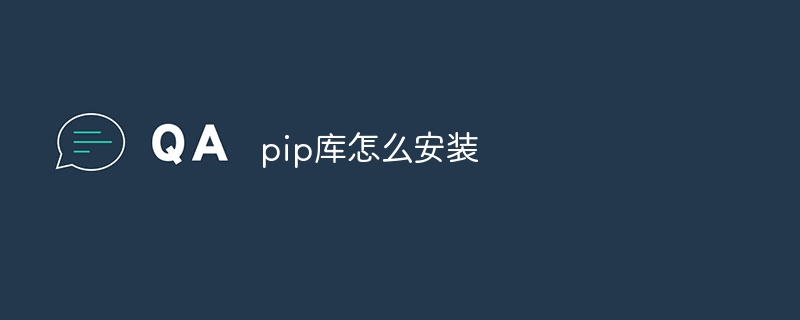
The pip library can be installed by installing Python, verifying Python installation, verifying pip installation, updating pip, installing Python packages, installing specific versions of packages, and installing packages from the requirements.txt file. Detailed introduction: 1. Install Python, go to the Python official website to download the latest version and install it; 2. Verify the Python installation, use the python --version command to verify whether Python is successfully installed; 3. Verify the pip installation, etc.

The operating system for this tutorial: Windows 10 system, Python version 3.11.4, DELL G3 computer.
To install the pip library, you can use the following method:
Installing Python
pip is a package management tool for Python, so you first need to install Python interpreter. You can go to the official Python website (https://www.python.org) to download the latest Python installation program and install it according to the instructions.
Verify Python installation
After the installation is complete, you can open a command line tool (such as Terminal or CMD) and enter the following command to verify whether Python is successfully installed:
python --version
If the installation is successful, the command line will output the installed Python version number.
Verify pip installation
During the installation of Python, pip is usually installed together. To verify whether pip has been installed successfully, you can run the following command in the command line:
pip --version
If the installation is successful, the command line will output the installed pip version number.
Update pip
If you have installed Python but the version of pip is older, you can use the following command to update pip to the latest version:
pip install --upgrade pip
Installing Python packages
Once pip is installed, you can use it to install Python packages. For example, if you want to install the requests package, you can use the following command:
pip install requests
This command will install the requests from the Python Package Download the requests package from Index (PyPI) and install it into your Python environment. Once the installation is complete, you can import and use the requests package in your Python project.
Install a specific version of a package
If you need to install a specific version of a Python package, you can specify the package name and version number after the pip install command:
pip install package_name==x.x.x
In this command, package_name is the name of the package you want to install, and x.x.x is the specific version number of the package you want to install.
Install packages from requirements.txt file
You can also record all the packages and their version numbers required by your Python project in a requirements.txt file , and then use pip to install these packages. In the requirements.txt file, each line represents the name and version number of a package, similar to this:
requests==2.25.1 flask==1.1.2
Then, execute the following command on the command line to install all required packages from the requirements.txt file :
pip install -r requirements.txt
This will install all packages and their corresponding versions listed in the requirements.txt file.
Conclusion
With the above method, you can install pip and use it to install Python packages to meet the dependency needs of your project. Remember to regularly use pip to update installed packages to ensure that the packages used in your project are the latest versions to get the latest features and security patches.
The above is the detailed content of How to install pip library. For more information, please follow other related articles on the PHP Chinese website!




